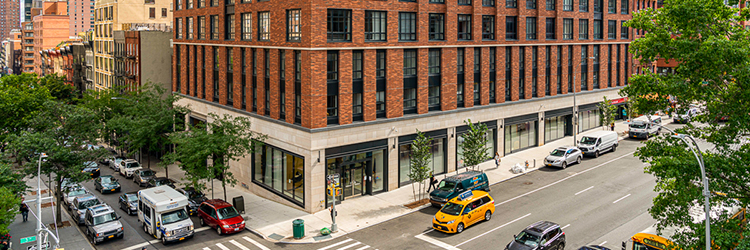News:
Shopping Centers
Posted: February 7, 2011
Can the functionality in obsolete malls be fixed? Can we reverse eroding income/investment dynamics?
This past November's ICSC/NAIOP Capital Conference in N.Y.C. discussed in detail the $1.5 trillion of commercial mortgages which are due to mature between now and December 2014. Approximately half of these mortgages are forecast to be financed conventionally, while the remaining balance of these maturing mortgages are believed to be over-leveraged or underwater.
Of the all the underwater loans of various asset classes in a lender's portfolio, the loan-type which most likely presents the greatest value recovery challenge to a lender is the class "B" regional mall, located in both primary and secondary markets. These loans whose underlying collateral are regional malls tend to be larger from a total dollar perspective relative to other commercial real estate loans. Importantly, this asset class is capital intensive for ordinary operations and general leasing, a fact that is often overlooked. When factoring in a true repositioning and overhaul of these assets, the capital investment can be substantial and at times daunting from a lender's perspective.
There are currently a few hundred class B or inferior regional malls country-wide which are in need of substantive repositioning in order to survive and remain competitive going forward. As it relates to underwater mortgages, property level fundamentals are more times than not unremarkable, and a substantial repositioning is generally imperative before property valuation erodes rapidly. Importantly, this erosion of value can often occur in a matter of months or years.
In a true Darwinian "Survival of the Fittest," many class B regional malls are forecast to shutter indefinitely, while others become white elephants in their respective markets. The former Scottsdale Galleria Mall in Scottsdale, Ariz. presents a prototypical case study of a mall's struggle to survive and adapt. The Scottsdale Galleria languished for over 10 years, nearly vacant, until a N.Y.-based investor purchased the property at a very attractive basis. Significant capital was invested in the property, which was successfully converted to class A office space.
In a recent trade interview, two respected industry experts opined on the determining factors of repositioning a mall and retaining a property as retail going forward. Steven Plenge, managing partner of Pacific Retail Capital Partners of Los Angeles, and Joseph Tagliola, managing partner of Collarmele Partners of Fort Lauderdale, Fla., have extensive experience in repositioning troubled properties and realizing their true potential value and have partnered on the acquisition and redevelopment of the West Oaks Mall in Houston, Tex.
In 2005, the West Oaks Mall was sold to its prior owner for $102 million. Due to the capital intensive nature of malls, as well as the requisite degree of expertise needed to operate these malls, the property languished. In December 2009, the property was sold by the foreclosing lender to Messrs. Plenge and Tagliola for $15 million. At that time, two of the five anchor buildings were vacant as were 35% of the mall stores. Plenge said, "This mall has the primary ingredients for a turnaround: a strong trade area, no new competition and tremendous voids in the market for unmet entertainment and retail demand. This property has many reasons to exist and thrive, and we intend to nurture it's proper repositioning. A strong tenant base exists, anchored by Macy's, Dillard's and Sears, whose sales are respectable and surprisingly resilient considering the state of the property. An exceptional opportunity exists to position this property as a one-stop-shop for a variety of market segments by adding entertainment uses, including a new multiplex theater with IMAX, a variety of restaurants, a leading nightclub operator, as well as a dominant grocer and junior anchors."
Another interesting redevelopment worth mentioning is the Bellevue Mall in Nashville, Tenn. George Tomlin is the CEO of GBT Realty Corp., whose firm is actively involved in redeveloping the property, which is considered by many to be a secondary market. A California-based company had planned to redevelop the mall in 2007, and a challenging economy and subsequent weak retail market put the redevelopment project on indefinite hold. Subsequently, the only retailer operating in the 850,000 s/f property since 2007 has been Sears.
Critical to GBT's overall redevelopment plan is a 39,000 s/f library facility with street and retail-floor entrances, as well as newly designed, community-oriented open spaces and common areas.
"These inviting spaces will serve as strong community facilities and gathering places, thereby making the property itself a community anchor while increasing overall foot traffic at the Bellevue Mall. In addition to a unique, community-desired property anchor, we are close to finalizing a number of deals with three other major, institutional-credit anchor tenants, as well as at least two junior anchor tenants in place by the Las Vegas ICSC in May 2011," said Ken Larish of GBT.
Tomlin said, "In addition to the retail and restaurant opportunities, we had gauged tremendous community support for a new library facility to replace the existing structure, as evidenced by tax increment financing that will go toward offsetting part of the construction costs. In addition to constructing the new library, the redevelopment will also include demolishing the enclosed mall portion of the property and constructing a streetscape boulevard through the middle of the property."
As evidenced by these two case studies, regional malls are capital intensive assets. The overall cost of maintaining these assets as such, and at times repositioning and maintaining these existing retail properties as retail going forward, can be costly and likely in the upwards of tens of millions of dollars. At times portions of a property can be maintained and tenanted as in the case of West Oaks Mall, and at times select properties require considerable new construction (i.e. the Bellevue Mall). In both cases, it is critical that preventative measures are taken before property dynamics are compromised and values erode to levels which eventually require complete redevelopment. From a lender's perspective, this might mean acknowledging that a mall's property value is merely worth less than 50% of the loan's par value.
Alan Goodkin is a managing director at Ackman-Ziff, New York, N.Y.
Tags:
Shopping Centers
MORE FROM Shopping Centers
2024 Year in Review: William O’Brien, M.C. O’Brien, Inc.
What noteworthy transactions or deals from this year best exemplified key market trends or shifts? I would like to say there was an outstanding transaction for me this past year but 2024 was more a culmination of long-term relationships, most of which continued to transact. Deals were smaller in many cases but we saw robust leasing both on the agency side as well as on the tenant side.






.gif)


.jpg)
.gif)